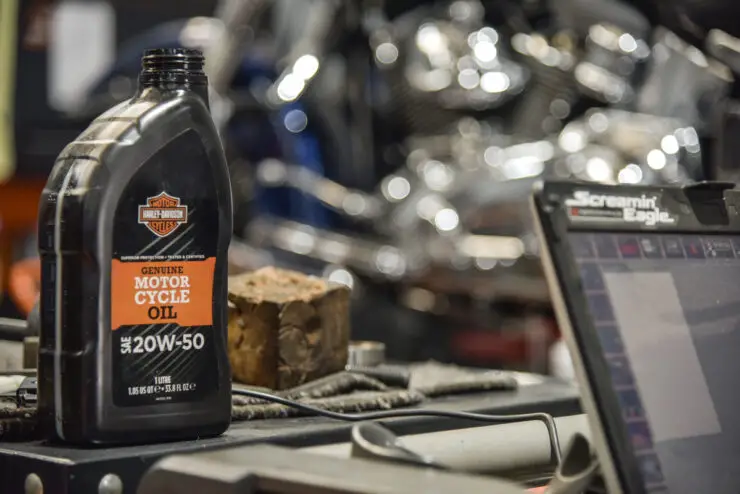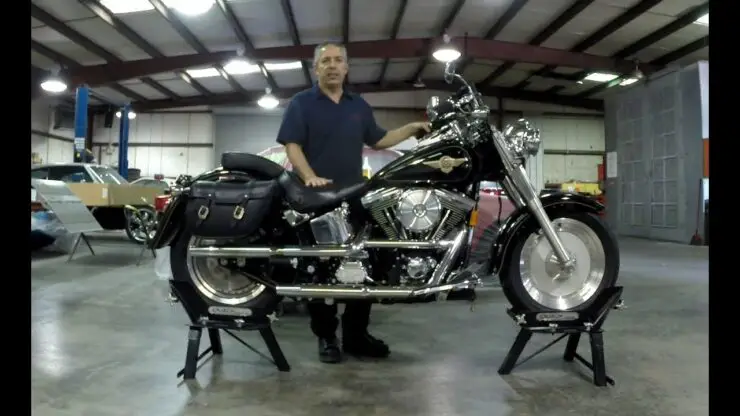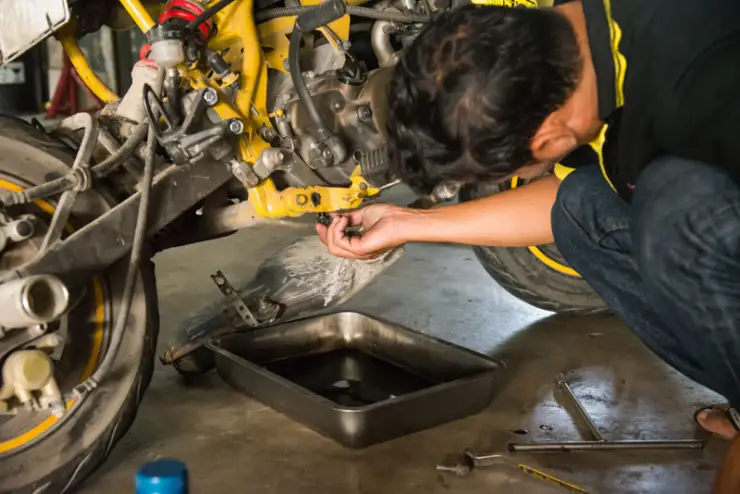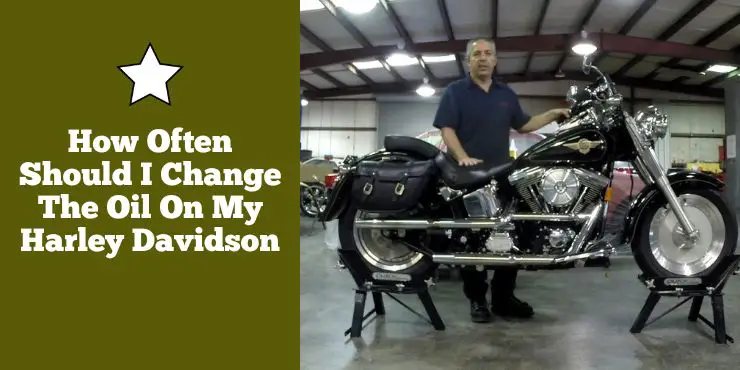Owning a Harley-Davidson is a great way to hit the open roads in style. But when it comes to proper maintenance, many Harley-Davidson owners may not know how often to change the oil. Whether you’re a new Harley-Davidson owner or a seasoned rider, understanding the importance of regular oil changes can help keep your bike running smoothly.
Change the oil on your Harley-Davidson every 5,000 miles for optimal performance, or sooner if riding conditions are severe, such as hot or dusty environments.
In this article, we’ll discuss the importance of oil changes and how often you should change the oil on your Harley-Davidson. Get ready to rev up your engine and read on to learn more!
Different types of oil used in Harley-Davidson bikes
When it comes to keeping a Harley-Davidson motorcycle running smoothly, choosing the right engine oil will be of utmost importance. The oil serves as the lifeblood of the motorcycle, lubricating moving parts, dissipating heat, and reducing friction. There are three types of engine oil that are commonly used for Harley-Davidson motorcycles – synthetic, semi-synthetic, and mineral oil. Each type of oil comes with its distinct advantages and considerations for motorcycle owners, depending on their preferences and riding needs.
>>> Click here to read our review of the Best Oil For Harley-Davidson <<<
Synthetic oil
Synthetic oil is engineered in a laboratory, using chemically synthesized base oils and additives to achieve specific performance characteristics. One of the major advantages of synthetic oil is its superior lubrication properties, which offer reduced friction, improved engine protection, and increased longevity. The uniform molecular structure of synthetic oil will allow it to flow more smoothly, even in extreme temperatures, which makes it an ideal option for riders who frequently encounter varying weather conditions.
Harley-Davidson motorcycles that come equipped with modern high-performance engines can benefit from the use of synthetic oil. Its ability to handle higher temperatures and provide enhanced protection against wear and tear makes it an amazing option for bikers seeking optimal performance and engine longevity.
Semi-synthetic oil
Semi-synthetic oil is essentially a blend of synthetic and mineral oil. It’ll combine the benefits of both mineral and synthetic oil while mitigating some of their respective drawbacks. The blend typically contains a higher percentage of mineral oil than synthetic oil, with synthetic additives for enhancing its performance.
This type of oil strikes the perfect balance between performance and cost-effectiveness, making it a popular choice for Harley-Davidson riders who want better protection than traditional mineral oil but might not require the full capabilities of pure synthetic oil. It offers impressive engine protection and decent temperature stability. These are the ideal option for Harley-Davidson bikers looking for moderate engine demands.
Mineral oil
Mineral oil or also known as conventional oil is derived from crude oil and refined through a traditional distillation process. It is the least processed of the three types of oil and contains fewer additives. Mineral oil performs adequately as an engine lubricant but might not offer the same level of protection and thermal stability as synthetic or semi-synthetic oil options.
Some older or less demanding Harley-Davidson models might be designed to use mineral oil. For riders with less intensive usage or those on a budget, mineral oil can still be a viable option for routine maintenance, especially for motorcycles not subjected to extreme riding conditions.

How often should I change the oil on my Harley-Davidson?
For Harley-Davidson riders, regular oil changes are important for maintaining the performance and longevity of their prized motorcycles. If you’re a beginner or a newbie, one of the questions you’re going to have regarding this situation is how often should I change the oil on my Harley-Davidson. The frequency of oil changes will depend on numerous factors, including engine type, riding conditions, and the type of oil used. Harley-Davidson offers guidelines for both standard and severe conditions, tailoring the recommended oil change intervals to ensure optimal engine health. Here is the answer to how often should I change the oil on my Harley-Davidson in different scenarios.
In standard conditions, the motorcycle isn’t subjected to extreme factors that can impact the engine’s performance or longevity. Standard conditions typically refer to regular highway or urban riding, moderate temperatures, and consistent riding without frequent stops and starts.
For Harley-Davidson motorcycles under standard conditions, the generally recommended oil change interval will be approximately once every 5,000 miles. This interval will apply to Harley-Davidson models with both conventional mineral oil and synthetic oil.
Meanwhile, severe conditions include factors that put added stress on the engine and require more frequent oil changes. Some of the severe conditions can involve any combination of high temperatures, short trips, extreme cold, stop-and-go traffic, and dusty or dirty environments.
- Riding in hot climates or during the scorching summer months can elevate engine temperatures and lead to quicker oil degradation
- Frequent stops and starts, such as in heavy city traffic, can increase engine stress and result in more rapid oil breakdown
- Consistently taking sort trips without allowing the engine to reach optimal operating temperatures can cause moisture and contaminants to accumulate in the oil
- Riding in frigid temperatures can thicken the oil, affecting its flow and lubrication properties
- Riding in dusty or dirty environments can introduce external contaminants into the engine, requiring more frequent oil changes
For Harley-Davidson motorcycles under severe conditions, the recommended oil change interval is typically around every 2,500 to 3,000 miles. Frequent oil changes will help ensure the engine remains well-lubricated and protected from the increased wear and tear associated with severe conditions.
It is important to note that the recommended intervals are general guidelines offered by Harley-Davidson. Owners must always consult the specific model’s owner’s manual for accurate and model-specific information regarding oil change intervals.
Common symptoms that your Harley-Davidson motorcycle needs an oil change
If you own a Harley-Davidson bike, you’ll be aware that proper maintenance will be important to keep your motorcycle running smoothly and performing at its best. One of the most important aspects of motorcycle maintenance will be regular oil changes. The engine oil in your Harley-Davidson motorcycle is its lifeblood, providing vital lubrication to moving parts and ensuring efficient operation. There are certain symptoms that will signal that it’s time for an oil change. Here are some common symptoms that might indicate that your Harley-Davidson motorcycle needs fresh oil.
Dark, dirty oil
One of the most apparent signs that your Harley-Davidson motorcycle requires an oil change is when the oil on the dipstick appears dark and dirty. Over time, engine oil will accumulate dirt, debris, and combustion by-products. As the oil ages, it’ll lose its effectiveness in lubricating and protecting the engine. If you notice that the oil has turned dark or has a gritty texture, it is a clear indication that it is time for a change.
Engine noise
As the oil degrades, it might not provide adequate lubrication to the engine’s moving parts. This can result in increased engine noise, often described as ticking or knocking sounds. Properly lubricated parts operate smoothly, minimizing friction and noise. If you’re hearing unusual sounds coming from the engine, it’ll be time to consider an oil change to prevent further wear and tear.
Reduced performance
As engine oil ages, its viscosity tends to decrease, affecting its ability to maintain proper lubrication under high temperatures and pressures. This can result in reduced engine performance, sluggishness, or a decrease in overall power. If you feel a noticeable drop in your Harley-Davidson bike’s performance, it’ll be a smart idea to check the oil and consider changing it if necessary.
Increased engine temperature
Fresh engine oil will help dissipate heat and regulate engine temperature. As oil ages and loses its lubricating properties, it might not be as effective in managing engine heat. If you notice that your engine temperature is climbing higher than usual, it’ll be a sign that your motorcycle’s oil needs replacement.
Oil leaks
If you find oil spots or puddles under your parked Harley-Davidson bike, it might indicate an oil leak. While an oil leak can have various causes, including worn gaskets or seals, it’ll be crucial for checking the oil level and condition. A significant oil leak can result in low oil levels, which can result in engine damage if not addressed promptly.
Check the engine light
Many modern Harley-Davidson motorcycles come equipped with onboard diagnostics that monitor various engine parameters. If the oil quality or level falls outside the extended range, the check engine light might illuminate on your motorcycle’s dashboard. This serves as an important warning to address any potential oil-related issues promptly.

Factors to consider when changing the oil in Harley-Davidson motorcycles
For Harley-Davidson motorcycle riders, changing the engine oil is an important aspect of routine maintenance. The engine oil serves as the lifeblood of the bike, playing a major role in lubricating moving parts, reducing friction, cooling the engine, and ensuring smooth performance. However, there are a number of factors that come into play when determining the appropriate time to change the oil. Understanding these factors will help riders make well-informed decisions to keep their Harley-Davidson motorcycles running at peak performance and ensure engine longevity.
Model of motorcycle
The model of the Harley-Davidson bike plays a vital role in determining the oil change intervals. Different models come with varied engine designs and specifications, which influence the engine’s oil capacity and how often the oil needs replacement. Newer models that deliver high-performance engines might require more frequent oil changes, especially when ridden under demanding conditions.
Harley-Davidson owners must refer to the bike’s owner’s manual or manufacturer’s recommendations for specific guidelines on oil change intervals based on their bike’s model and engine type. Adhering to these guidelines will help you maintain the engine’s efficiency and performance.
Operating conditions
The operating conditions in which a Harley-Davidson motorcycle is ridden will significantly impact the engine’s stress and wear. Riding in extreme temperatures, stop-and-go traffic, or dusty environments can put added strain on the engine and might require more frequent oil changes.
For bikers who frequently encounter adverse conditions, using a high-quality synthetic oil can provide better protection against wear, higher temperatures, and enhanced lubrication, ensuring the engine remains in top shape.
Maintenance history
The motorcycle’s maintenance history will also influence the timing of oil changes. Regular and timely oil changes will be essential for keeping the engine healthy and extending its lifespan. Neglecting routine maintenance, including oil changes, can result in sludge buildup, reduced lubrication, and increased engine wear.
Keeping a comprehensive maintenance log that includes oil change dates and mileage will help riders track the oil change intervals accurately and ensure timely service. If the motorcycle’s maintenance history is unknown or inconsistent, it is advised that you should perform an oil change at the recommended interval or as advised by a qualified mechanic.
Oil type
Choosing the right type of oil will be paramount for Harley-Davidson motorcycles. Synthetic oil offers superior performance and protection, especially for high-performance engines. It provides better temperature stability, reduced friction, and increased engine longevity compared to conventional mineral oil.
Semi-synthetic oil blends offer a balance between cost-effectiveness and performance, which makes them a suitable option for riders with moderate engine demands.
Oil change interval
The frequency of oil changes will vary depending on the model of the Harley-Davidson bike, engine type, and operating conditions. Newer models with high-performance engines might require more frequent oil changes, especially if ridden under demanding conditions like extreme temperatures or heavy traffic.
Meanwhile, older models or bikes with less intensive usage might have longer oil change intervals. Owners must refer to the owner’s manual for specific guidelines on oil change intervals and adhere to them for keeping the engine in top shape.
Oil quality
The quality of the engine oil will be important for the overall health of the bike’s engine. Using a high-quality oil that meets or exceeds the manufacturer’s specifications will be important. Synthetic oils, in particular, will offer superior performance, better temperature stability, and improved engine protection compared to conventional mineral oils. However, it is important to use the type of oil recommended for the specific bike model.
Oil level and condition
Before changing the oil, it’ll be important to check the oil level and condition. Insufficient oil levels can result in inadequate lubrication while contaminated or degraded oil might not provide adequate protection to the engine. Regularly inspecting the oil level and monitoring its condition can help identify potential issues early on and prevent major engine problems.
Oil filter replacement
Along the changing the engine oil, it is equally important for replacing the oil filter. The oil filter removes impurities and contaminants from the oil, ensuring clean and effective lubrication. A clogged or old oil filter can compromise engine performance and reduce the effectiveness of fresh oil.
Professional inspection
For some Harley-Davidson riders, self-maintenance might not be feasible or practical. In such cases, seeking professional inspection and oil change services from authorized Harley-Davidson dealerships or certified mechanisms can ensure that the motorcycle receives the care it deserves.
Professional technicians have an impressive understanding of Harley-Davidson bikes and can recommend the appropriate oil type, change interval, and perform comprehensive checks on the bike’s overall health.
Tips to keep in mind when changing the oil in your Harley-Davidson bike
Changing the engine oil on your Harley-Davidson motorcycle is a fundamental aspect of routine maintenance for ensuring engine longevity and optimal performance. Properly carried-out oil changes will help keep the engine running smoothly, reduce wear and tear on vital components, and enhance the overall riding experience. Whether you are a new Harley-Davidson owner or a seasoned Harley enthusiast, there are a few essential tips that you must remember when changing the oil in your bike.
Arrange the right tools and materials
Before you start the oil change process, gather the necessary tools and materials. You will require a wrench or socket set for removing the drain plug, an oil filter wrench for replacing the oil filter, a drain pan for collecting the used oil, and the correct type and quantity of new engine oil recommended for your bike.
Review the bike’s owner’s manual
The bike’s owner’s manual will be your ultimate guide to proper motorcycle maintenance, including oil change instructions specific to your bike’s model. You should review the manual thoroughly before proceeding with the oil change. Pay close attention to the recommended oil type, oil capacity, and the frequency of oil changes for different conditions.
Warm up the engine before changing the oil
To make sure that the old oil drains much more effectively, you need to warm up your Harley-Davidson bike’s engine before beginning the oil change. Allow the engine to run for a few minutes to heat up the oil. This will make it flow more freely and enable a more complete drainage.
Place your bike on a level surface
Before you can start changing the oil, you’ll need to park your Harley-Davidson bike on a level surface before starting the oil change. This will ensure that the motorcycle is stable and prevents any oil spills while draining the old oil.
Prioritize your safety
You must always wear protective gear, including a pair of gloves and safety goggles during the oil change. This will allow you to prevent any contact with hot oil or potential spills. Safety must always be your first priority when performing any maintenance tasks on your bike.

Remember to drain the old oil completely
When draining the old oil, you must make sure that you remove the drain plug completely for allowing all the used oil to drain into the pan. While the oil is draining, you must inspect the drain washer for signs of wear or damage. Replace it if needed to prevent potential leaks.
Replace the oil filter
As a part of the oil change, it’ll be important to replace the oil filter. Remove the old filter using an appropriate oil filter wrench and install a new one, ensuring that it is tightened to the manufacturer’s recommended torque specifications.
Refill with the correct oil
Once you have drained the old oil and replaced the oil filter, refill the engine with the correct type and quantity of new oil. You must be mindful that you don’t end up overfilling as it can lead to engine damage. Either go for oil options sold by Harley-Davidson or a reliable aftermarket brand known for selling oil that meets OEM specifications.
Dispose of old oil responsibly
You should properly dispose of the used oil and oil filter. Many local auto parts stores or recycling centers accept used oil for recycling. Avoid pouring used oil down the drain or discarding it inappropriately, as it could harm the environment.
Double-check for leaks
Before you take your Harley-Davidson motorcycle out for a ride, you should double-check for any oil leaks around the drain plug and oil filter. If you detect any leaks, address them immediately to avoid potential engine damage and ensure a leak-free ride.
FAQ
How often should I change the oil on my Harley-Davidson?
It is recommended to change the oil on your Harley-Davidson motorcycle every 5,000 miles or 6 months, whichever comes first. This should be done more frequently if the motorcycle is ridden in dusty or wet conditions, if it is used for long-distance touring, or if it is used for off-road riding.
What type of oil should I use for my Harley-Davidson?
It is recommended to use a high-quality, synthetic oil specifically designed for Harley-Davidson motorcycles. This type of oil is designed to provide the highest levels of protection and performance for your Harley-Davidson engine.
What other maintenance should I perform on my Harley-Davidson?
In addition to changing the oil, other important maintenance tasks for your Harley-Davidson include checking and replacing the air filter, inspecting and cleaning the spark plugs, checking the battery, and lubricating the drive chain. It is also important to inspect the brakes, tires, and other components to ensure they are in good working condition.
>>> Read more about Oil for Harley-Davidson <<<

